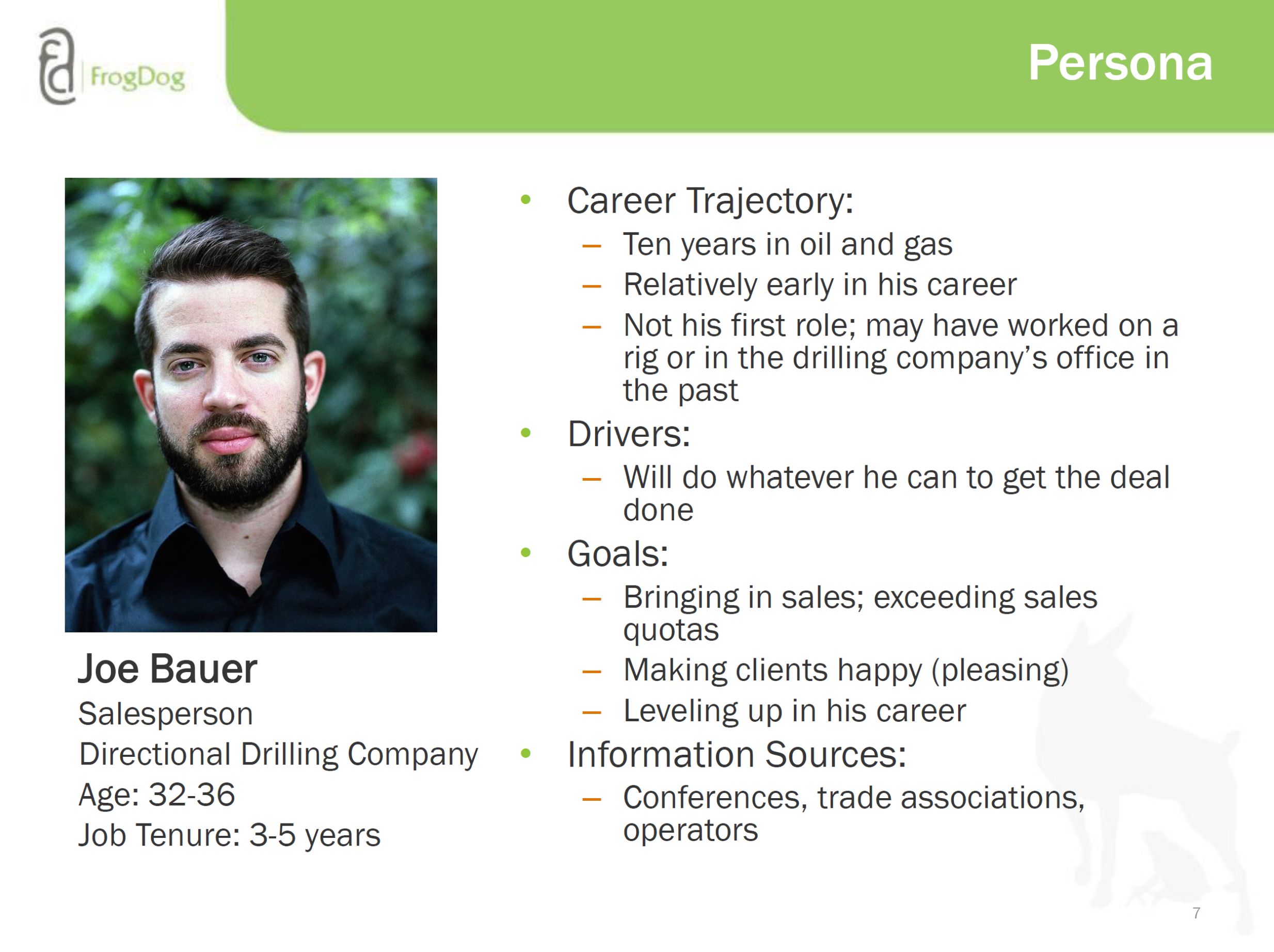
What are Marketing Personas?
What are marketing personas? Why do we create them and how are they used? What are their benefits and limitations?
Personas are composite creations—aggregates designed to approximate the predominant archetypes of people in a target group. As with every aggregate, there are outliers in each group that will not fit within the group’s persona.
Say what?
When to Create a Persona
Developing personas makes sense in two situations:
- when you are analyzing the research of a population or group and discover that there is more than one subgroup within the research pool
- when you need a quick-reference guide to help you remember key points about your target audience
A persona helps give people on your marketing and sales teams a touchpoint for their target audiences and for each target audience's key drivers.
For example, FrogDog needed to market a client’s product to small, independent dental practices. To effectively convince the practices to switch venders for this type of product, our research found that we needed to engage with each practice’s office manager and its dentists. Unless these two audiences bought into the product, the dental practice would not make the switch.
Office managers, who run the business side of a dental practice, and dentists, who run the clinical side of a practice, have very different responsibilities and, therefore, very different areas of interest and focus. In the case of this strategy development, developing personas to provide a shorthand visualization of each target audience helped us create a picture in the minds of the client company's leadership and sales teams and helped crystallize our efforts around two central figures in designing a marketing approach.
Personas have value beyond marketing to external audiences as well. For one client, FrogDog conducted an in-depth research project to assess the employee population of a company with four hundred staff members across three offices with a variety of job titles. The company wanted to better understand its employee population so that it could improve internal communications, create employee-benefit packages of value to their teams, and more effectively conduct employee training.
As you can imagine, this broad an employee population had a variety of archetypes—and, therefore, personas. Developing personas for subgroups of this client's employee population helped FrogDog and the client company design engagement activities and benefit packages that addressed each of the predominant employee types.
What’s in a Persona?
Personas can include the average demographics of the aggregate—age, income level, education level, and so forth—but not always. Personas can even include a photo and a name to help the company quickly reference and visualize the archetype the persona embodies (it is far easier for a team to call “Bill” to mind than it is for the team to conjure “Persona C”).
You can go into granular detail, but your persona might get too complex if you do. Aim to include only the details your persona needs to help you plan. For example, income level matters in some situations more than others, as does education level and the number of people in the persona’s household.
For example, for the employee-engagement research project mentioned earlier in this article, we didn’t feel that salary level or household income mattered much to the research objectives. The company’s goal was to better understand its employee population so that it could develop benefits and engagement programs to increase satisfaction and retention. Yet, for product marketing, income level can matter significantly.
For another client, FrogDog determined through primary and secondary market research that the primary decision maker for one of the company's products had a very specific job title and that the people in this role across prospective client companies had very specific characteristics. To help us keep this target audience top of mind and to provide the client's sales and marketing teams a quick-reference touchpoint for the target audience as we moved forward into developing messages and sales and marketing activities, we developed the below persona slide.

How to Use a Persona
Companies predominantly use personas as quick-reference guides that represent distinct target audiences.
Personas have many important uses in marketing, customer relations, employee relations, product and service development, and overall business strategy and planning.
Having personas for each of your key stakeholder groups will help you
and your team keep top of mind the perspectives and lifestyles of your
target audiences. In doing so, you'll be able to more efficiently and
effective develop messages, marketing materials, marketing tactical
mixes, corporate activities, products and services, and more.
When you ensure you develop messages, materials, and activities tailored to each persona, you help to ensure you cover all your important bases and can more easily achieve measurable results from your marketing activities.
Need Persona Help?
Need help with target audience research and designing personas for your key audiences? FrogDog to the rescue!
Image credit: https://www.pexels.com/@olly
Updated: Aug 31, 2020

We do not spam. And you can unsubscribe when you want.